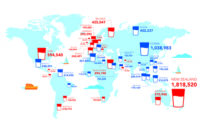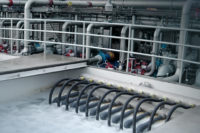Water Filtration
Seal selection for water filtration is a balancing act
Make the right seal selection for water filtration equipment without sacrificing what’s important

Filtration systems, including those for water filtration, play a key role in helping to prevent food contamination. Due to an increasing emphasis on this, the food and beverage (F&B) filtration systems market is seeing growth. According to a January 2020 Technavio research report, it is projected to grow at a 7% CAGR from 2020 to 2024, when the market is expected to reach $975.25 million. With advancements in the filtration market, F&B processors are now focusing their attention on high-performance, technically advanced filtration systems that are introducing new considerations for seal selection.
This article explains how to select the right seals for water filtration systems, how to ensure regulatory compliance, and what design elements to consider so required hygiene levels are met.
Water filtration systems, like other F&B processing systems, use chemicals that are destructive to elastomers—the most common seal materials. Municipal water supplies often contain chlorine, chloramine, or both; seals must be able to withstand these media. Industry regulations, such as the United States Food and Drug Administration (FDA), National Science Foundation (NSF), and the European Union (EU) Food Contact Material Regulations also need to be taken into account.
Basic considerations
Water is a universal solvent, dissolving more substances than any liquid in the world. It is the number one ingredient in many F&B processing applications and, even if it is not an ingredient in a food or beverage product but used in F&B processing, it still needs to meet high purity standards. To ensure this, filtration is necessary to remove chlorine and/or chloramine from municipal water supplies, and sulfur or other minerals from underground water sources.
To specify the right seal for a filtration application, the chemical composition of the water being filtered needs to be known, along with the other media that will clean the system. Although elastomer is the most common sealing material used in water filtration systems, the sealing materials used need to be specified correctly. Rubber absorbs water over time, which can affect seal integrity and lead to unexpected leakage. Thus, a specialized elastomer or plastic alternative is required.
In general, it’s best to select a compound that’s as resistant as possible to the known conditions in the filtration system, including chemicals, temperature, pressure, and the surface roughness of the system’s components. In addition, the necessary physical properties, including compression set, tensile strength, yield and elasticity need to be identified. Seal manufacturers’ material data sheets typically provide this information, and their engineering experts are available to answer questions.
Regulations
The same FDA regulations apply to water filtration systems as other F&B systems. Depending on the application, the seal material must also be on the FDA’s White List, a list of compounds that have passed FDA extraction tests.
NSF International’s NSF/ANSI 51 and NSF/ANSI 61 standards specify materials and finishes used in the manufacture of food equipment. The latter regulates materials or products that come into contact with drinking water. The application will determine which of these standards applies to a system.
Food processing equipment sold or operating in Europe must also meet the European Union’s Food Contact Material rules, which establish general safety and inertness principles for all materials that come into contact with food, and/or meet the relevant EU drinking water requirements. These requirements include the elastomer guide (ELL), the German Federal Institute for Risk Assessment (BfR), Water Regulations Advisory Scheme (WRAS), the Accréditation de Conformité Sanitaire (ACS), Conformité Européenne (CE), and others.
As a rule, to prevent microbiological growth, it’s important to make sure any seal used in a water filtration system meets FDA, NSF, and relevant EU requirements, just like all components in food processing facilities.
Hygienic design
In addition to meeting regulations, ensuring a hygienic sealing design, which avoids bacterial growth and facilitates regular aggressive cleaning regimes, is important.
Although not a federal standards body, 3-A Sanitary Standards, Inc. offers comprehensive guidelines regarding how to design seals and hardware to ensure the F&B processing equipment's contact surfaces can be cleaned using automated equipment and dismantled for manual cleaning.
In addition to following 3-A’s 18-03 guidelines for elastomers or 20-27 for plastics, it’s important to aim for an appropriate surface finish (i.e., 32µin Ra) to ensure there are no pits, folds, or crevices where bacterial growth can occur.
Seals used in water filtration systems must also be able to withstand the rigors of in-place cleaning processes. Where used, that means compatibility with the chemicals in clean-in-place (CIP) and sterilization-in-place (SIP) regimes. In other cases, it means tolerating hose downs, with or without chemical additives under pressures up to 1450 psi and temperatures up to +302 °F. These sealing systems must, in addition, be capable of withstanding backflushing processes containing cleaning chemicals.
When specifying seals, it is critically important that filtration equipment manufacturers inform food processors about the chemicals that should and should not be used to clean the system. If the food processor’s operations department does not have this information and decides to change the chemicals used in cleaning all or part of a water filtration system, the seals can degrade and cause leakage. Using a seal material that’s compatible with a wide range of chemicals can reduce the likelihood of this scenario.
Keep in mind that seals may come in contact with a municipal water supply and should be resistant to both chlorine and chloramine. ASTM International’s D6284 offers information on standard test methods to determine the effect of these chemicals on rubber. Ask your seal supplier for chlorine and chloramine resistance performance test data.
Ethylene propylene diene monomer (EPDM) can be formulated to have less carbon content, creating a flexible seal that holds up well to chlorine and chloramine. Polytetrafluoroethylene (PTFE) and silicone tend to perform well with these chemicals. Although nitrile rubber’s (NBR) physical properties are well suited to many water filtration system components, NBR absorbs chlorine and chloramine, causing swelling and other issues. Therefore, it should be avoided in systems that use a municipal water supply containing chlorine or chloramine.
Understanding use cases
No seal will last indefinitely, so aim to select one that will last as long as possible in the application, and design the component’s maintenance cycle accordingly based on predictions from suppliers regarding when seals should be replaced.
Planning for eventual seal deterioration and understanding how to balance seal life, physical properties, chemical compatibility, and ease of installation and maintenance, will greatly help with successful seal selection. Following these recommendations and employing good engineering practices will extend the life of water filtration equipment, preventing microbiological growth in the system, and ensuring the water filtration equipment meets applicable industry standards for cleanliness and hygiene.
An effective partnership between a filtration equipment manufacturer and its seal supplier can result in a minimized total cost of ownership. This can be achieved by balancing acceptable maintenance levels with the predicted failure life of a sealing material. In some cases, a higher cost material may result in an overall reduction in the total cost of ownership as the time between planned maintenance can be extended.
Harlan Hart is Technical Manager at Trelleborg Sealing Solutions, tss.trelleborg.com.
Looking for a reprint of this article?
From high-res PDFs to custom plaques, order your copy today!






